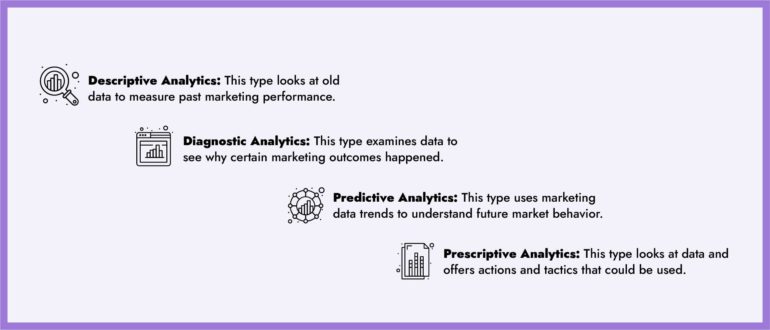Imagine having a tool that tells you what products your customers want, when they want it, and how they want to receive it. That’s the power of data-driven marketing. It’s like possessing a guide to understanding your customers’ desires and thoughts.
Let’s check the details.
What is Data-Driven Marketing?
Data-driven marketing is a way for businesses to make better decisions and act in their marketing based on the data they receive. It’s about using data analysis to learn about customers’ habits, likes, and trends and then using that information to make smart marketing decisions.
Let’s say you’re running a coffee shop. By looking at your sales data, you notice that more lattes are sold on cold mornings. With this insight, you could create a special offer for lattes on chilly days, attracting more customers. This is valuable information — a piece of data-driven insight. With this knowledge, you can make a strategic marketing decision. For instance, on cold days, you could offer a special promotion, like “Warm up with our Latte Special!” This targeted approach is likely to attract more customers, as it directly responds to their preferences indicated by the sales data.
Types of Marketing Analytics

- Descriptive Analytics: This type looks at old data to measure past marketing performance.
- Diagnostic Analytics: This type examines data to see why certain marketing outcomes happened.
- Predictive Analytics: This type uses marketing data trends to understand future market behavior.
- Prescriptive Analytics: This type looks at data and offers actions and tactics that could be used.
Benefits of Marketing Analytics in Decision-Making
Data analysis is one of the best digital marketing strategies for business growth and can give you a lot of useful information that can make your marketing efforts much more effective and efficient:
- Understanding Customer’s Psychology: Data research helps marketers figure out what their customers want, how they usually buy things, and what they like. Using analytics helps you create marketing strategies that reach the right audience at the right time. Also, this way you can find out which products are more popular among your customers and produce these products more effectively.
- Improving Personalization: When you understand what your customers like, you also make your marketing strategies more personalized. This way, you can offer them products that fit their taste.
- Optimizing Marketing Spend: When you check the data, you also understand which channels and projects get the best return on investment (ROI). This way you can use your money more wisely and focus on strategies that work best for you.
- Predicting Future Trends: Businesses can see trends and changes in customer behavior by looking at market data. Netflix used data analysis to create its hit series ‘House of Cards.’ By analyzing viewer preferences for political dramas and their positive responses to works by director David Fincher and actor Kevin Spacey, Netflix identified a winning combination. This data-driven approach led to the development of a highly successful show tailored to their audience’s tastes.
- Improving Product Development: Data analysis helps you create new products as well by measuring marketing performance. By using your data, you understand the popular products and can create similar products based on that. For example, if you know that people love buying plates with Van Gogh’s paintings, you also know that they will buy t-shirts with his paintings as well.
- Competitive Advantage: If you use data-driven marketing, you have an edge over your competitors.
- Risk Management: Analyzing data well can also help you find possible risks in your marketing plans. This way of making decisions is based on facts, which lowers the risks that come with guessing and opinions.
- Increasing Productivity and Efficiency: Marketing teams can work more quickly when they have ideas based on data. They don’t guess as much and instead, focus on putting plans into action that they know are more likely to work.
- Global Reach and Localization: Businesses that do business around the world can learn about regional tastes and cultural differences by analyzing data. This helps make sure that your marketing plans are relevant and successful in different areas by creating personalized plans for each one.
How to Use Analytics for Better Decision-Making?

The business world is based on data, so using statistics to make better decisions is important. This step includes gathering, studying, and making sense of data to help lead business decisions and actions. Here are some good ways to implement marketing data solutions:
- Set Clear Goals: To begin, you should think about what you want to achieve with your data. Clear goals could include things like making customers happier, making more sales, cutting costs, or better product development.
- Collect Useful Information: Collect information that will help you reach your goals. There are many places where this information can come from, like customer polls, sales reports, social media, organizational systems, and tracking your online behavior.
- Make Sure the Quality of the Data: It is very important that the data is correct and full. Clean up your data to get rid of any mistakes, copies, or inconsistencies. When you have reliable info, you can do more accurate research and make better decisions.
- Pick the Right Analytical Tools and Methods: You can use different analytical tools and methods depending on your goals. Tools can be anything from simple software for statistical analysis to complex methods for machine learning. Which tools you use will depend on how complicated the data is and what you want to learn from it.
- Do Descriptive Analytics: To learn about what happened in the past, start with descriptive analytics. Look at old data to find patterns, trends, and reference points.
- Use Diagnostic Analytics: To figure out what happened, use diagnostic analytics. This needs more in-depth research, like association and regression analysis, to find out what causes what.
- Predict Future Trends with Predictive Analytics: To guess what trends will happen in the future, use predictive analytics. Statistical models and machine learning could be used to guess what will happen by looking at past data.
- Use Prescriptive Analytics to Make Strategic Decisions: This type of analytics goes one step further by telling you what you can do to get the results you want. This is done with complicated formulas and is often used to make big decisions.
- Visualize Data to Better Understand It: Tools for visualizing data, such as screens and graphs, make it easier to understand large sets of data. They help people who make decisions understand complicated ideas and quickly spot new patterns.
- Always Keep an Eye on and Analyze Data: Make statistics a continuous process. Monitoring and studying data all the time is a good way to keep up with changing customer habits and market trends.
- Encourage a Data-Driven Culture: Get everyone in the company to make decisions based on data. Teach your staff how to understand data analytics and use it in their daily work.
- Evaluate and Change: Finally, it’s important to keep an eye on how your choices based on analytics are working out. You should be ready to change your plans and strategies as you learn more from your data.
Data Analysis for Marketing from Different Brands

Here are the marketing insights of the data analysis from famous brands:
- Amazon: This was one of the first companies to use predictive analytics. They use complicated formulas to look at customer behavior, tastes, and past purchases. This information is used to make personalized product suggestions, which greatly increases sales and customer involvement.
- Starbucks: To figure out where things are, Starbucks uses data analytics. They decide where to open new shops by looking at things like customer flow, demographic data, and how people buy things in certain areas. This method has helped them grow and be successful around the world.
- Coca-Cola: When it comes to internet marketing, Coca-Cola has turned to “big data.” They make their marketing efforts more effective and interesting by looking at customer behavior and social media data. This makes their brand visibility and interactions with customers much better.
- Nike: Data analytics are used by Nike not only for marketing but also for making new products. Nike+ is a fitness app that gives the company information about its users’ exercise habits and tastes. This information helps the company make decisions about how to create products and sell them. This method has helped them make products that are more unique and that people want.
- Spotify: One great example is how Spotify uses data analytics to make the user experience more unique. By looking at how people listen, they make custom mixes and offer new music that fits each user’s tastes. This makes users more engaged and satisfied.
- Zara: Zara is unique in the fashion world because it uses statistics in its fast fashion. Zara quickly changes its clothes designs to follow the latest fashion trends by looking at sales and customer feedback data. This helps them stay ahead in a very competitive market.
Using data and analytics to their full potential helps businesses better understand and manage the complicated world of marketing, leading to long-term growth and success. Use data analysis for your marketing efforts and see great results.
FAQs
How does analytics help decision-making?
- Analytics helps people make decisions by giving them new ways to look at data, finding patterns, guessing what will happen, and using tactics that are based on facts.
What are the 4 types of data analytics to improve decision-making?
- Descriptive Analytics (what happened)
Diagnostic Analytics (why it happened)
Predictive Analytics (what could happen)
Prescriptive Analytics (what should be done)
What are the 3 areas of analytics that can contribute to decision-making?
- Customer Analytics (understanding customer behavior)
Operational Analytics (optimizing operations)
Financial Analytics (managing financial resources)
Does the analysis of data help make better decisions?
- Yes, analyzing data is an important part of making better decisions because it gives you realistic, data-driven ideas that help you make good choices.




